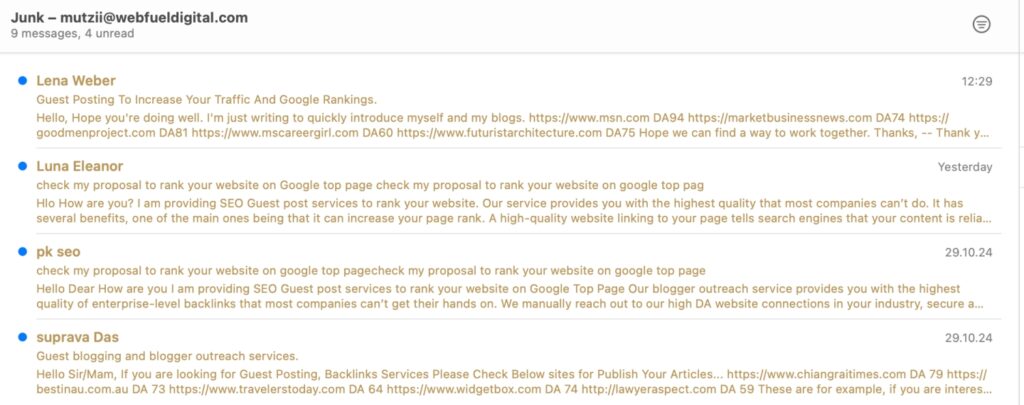
10 SEO Practices You Need to Drop in 2024 (or Sooner)
If you’ve been in SEO for a while, you’ll know our industry has always had its share of fads, trends, and shady techniques. I’ve been around since the late 2000s (makes me feel so old just saying it!), so I’ve seen it all – the good, the bad, and the outright ridiculous. But the shocking part? Some of these outdated or questionable practices are still being used, and, quite frankly, they’re doing more harm than good.
So, let’s have a heart-to-heart about the SEO practices we really need to leave in the past. It’s time to clear out the dead wood. You might recognise yourself in some of these, and if that’s the case, don’t feel bad – we all do what we think is best at the time. But it’s high time we evolve and focus on strategies that actually make a difference in today’s SEO landscape.
Table of Contents
1. Following a Checklist of Do’s and Don’ts
Let’s start with the tendency to rely on rigid SEO checklists. Following a checklist is like that kid in school who aced every test because they memorised the book but didn’t actually understand a word of it. They might pass, but ask them a question that isn’t in the book, and they’re lost.
Checklists can be useful, especially when you’re just starting out, but they shouldn’t define your SEO strategy. Mastering a list of “rules” doesn’t make you a good SEO, just like memorising every word in a textbook doesn’t make someone an expert. SEO is complex and constantly evolving. A checklist won’t give you the insight to know when to change course, try something new, or go against the grain when the situation calls for it.
What to Try Instead: Use checklists as a learning tool, but focus on developing an adaptable SEO mindset. Rather than blindly following rules, understand why they matter. Get comfortable with testing, experimenting, and refining your approach. SEO success is about flexibility, not rigidity.
2. Relying Too Much on SEO Tools
Right up there with checklists is the habit of over-relying on SEO tools. Tools like Ahrefs, SEMrush, and Google’s own suite of tools can make our lives easier, no doubt. But lately, I’ve noticed that some SEOs define their skillset by the tools they use rather than their actual understanding of SEO principles. It’s like thinking you’re a chef because you own a great set of kitchen gadgets – gadgets can help, but they don’t make the chef.
SEO isn’t something you can “outsource” to a tool. Tools are a guide, not a crutch. I’ve seen folks who rely entirely on tools to decide what to optimise, but what happens when the data is misleading or flat-out wrong? Even Google’s tools occasionally get it wrong, so blind faith in tools is a dangerous game. Sometimes, the right move is based on instinct, creativity, and knowing your site’s goals – things no tool can calculate.
What to Try Instead: Use tools as a baseline for insight, but get comfortable going beyond the data. Do competitive research, manually explore your site, and regularly check your keywords in live search to see how things look from a user’s perspective. Build a foundation on SEO basics and layer in tools to support your strategy, not define it.
3. Prioritising Quantity Over Quality
There’s a big trend lately toward “topical maps” as a way to build topical authority and E-E-A-T (Experience, Expertise, Authoritativeness, and Trustworthiness). I’m all for covering relevant topics thoroughly, but I feel this “mapping” approach often goes overboard. Some SEOs are chopping every topic into multiple articles, creating thin, repetitive content that feels like article spinning with a fresh coat of paint.
Let’s be real: Google isn’t stupid. Updates like Panda and Hummingbird were created to weed out low-quality, thin content. Google wants well-researched, insightful content that provides actual value – not a bunch of keyword-stuffed articles that all basically say the same thing. If you can answer a topic well in one article, why chop it up into ten? Quality always beats quantity, and in the end, people and search engines alike can tell the difference.
What to Try Instead: Focus on creating fewer, more comprehensive articles that cover topics in depth. Use the topical map to structure each piece, but bring all the information together in a way that’s useful and easy to navigate. Aim to be the go-to resource on a topic, rather than just producing content for content’s sake.
4. Focusing Only on Top-of-Funnel Keywords
Here’s a truth bomb: aiming only at high-volume, top-of-funnel keywords is a trap. It’s like fishing with a huge net in a tiny pond – sure, you’ll catch something, but it won’t be the quality you’re after.
Think of SEO like a full journey rather than a single destination. You need keywords that target all stages of the buyer’s journey – awareness, consideration, and decision-making. Only focusing on top-of-funnel keywords is a rookie mistake because you’ll be drawing in people who are only mildly interested, and most won’t convert. Imagine a cake shop that only advertises flour – it’s a key ingredient, but you’ve got to sell the whole cake if you want customers who are ready to buy.
What to Try Instead: Map out the buyer’s journey and align keywords to each stage. Research middle- and bottom-funnel keywords that cater to users who are further along in their decision process. This layered approach will attract both information-seekers and those closer to conversion.
5. Buying Expired Domains
Here’s one for the retro SEO crowd. Recently, I joined an SEO Facebook group, and what did I see? People still selling expired domains like it’s 2005. Seriously, seeing people buy and sell domains with the idea that it’s going to be their ticket to SEO gold is like joining a nostalgia club.
Once upon a time, expired domains might have offered a little shortcut, but those days are over. Google’s far too smart to let a domain’s past life boost its current ranking out of the blue. It’s better to focus on building a solid brand and creating quality content that actually resonates with your audience than to hope for some magic domain juice.
What to Try Instead: Build your brand from the ground up with a fresh, unique domain. Concentrate on creating valuable content, building a strong user experience, and fostering authentic brand trust. Over time, these efforts will build lasting authority.
6. Parasite SEO
Closely related to expired domains is the tactic known as “Parasite SEO.” This strategy involves piggybacking off someone else’s domain authority by publishing content on high-authority sites to boost rankings for certain keywords. It might look clever on paper, but it’s risky and unsustainable.
When you depend on someone else’s domain authority, you’re putting your entire strategy on shifting sands. The minute that site changes its policies, you’re out in the cold. Google is also cracking down on this approach, and it’s easy to get penalised. In the long run, creating your own solid foundation is way more reliable than banking on someone else’s site.
What to Try Instead: Focus on building your own authority. Publish high-quality, unique content on your own domain. Foster relationships with reputable sites in your industry, but always bring the traffic and authority back to your own brand.
7. Exact Match Domains (EMDs)
Ah, the “Exact Match Domain” – another classic. Just last week, a client asked me if they should buy a domain that perfectly matched a keyword phrase. And I get it. Decades ago, having an EMD was like hitting SEO gold. But times have changed.
Today, SEO is more about brand authority and user experience than having a domain name stuffed with keywords. Google’s focus has shifted; it wants to see brands that resonate with users, not just keywords. So, if you’re still in EMD territory, it’s time to move on. Focus on branding instead – a memorable brand name will do far more for you than a clunky, keyword-stuffed URL.
What to Try Instead: Create a domain name that reflects your brand’s identity, not just keywords. Choose something memorable, easy to spell, and resonant. Google’s more interested in solid brands than keyword-crammed URLs, so focus on building brand loyalty and recognition.
8. Buying or Exchanging Links
Now, here’s a juicy one. My inbox is bombarded daily with backlink offers from companies who clearly have zero idea what I’m working on or what my goals are. It’s laughable! And yet, people still fall for it.
Buying or trading backlinks is risky business, especially with Google’s recent core updates targeting sites with suspicious backlink profiles. It’s a tactic that might work in the short term, but sooner or later, Google’s algorithms will catch up. I’ve seen a lot of digital PR agencies and publishers who rely heavily on sponsored posts get hit massively by Google’s March update. These sites took a huge hit, with rankings plummeting overnight – and digging out from that penalty is no easy task.
The takeaway? You don’t want your site to be the next victim. If you’re building links, be strategic and stay focused on quality, relevance, and authenticity. The landscape is shifting constantly, and Google’s becoming more vigilant with every update – make sure your approach to links is above board to avoid being caught in the crossfire.
What to Try Instead: Develop a natural link-building strategy by creating link-worthy content, partnering with industry influencers, and securing guest posts on reputable sites. Focus on earning links that are genuinely relevant to your audience and niche.

9. Thinking That Backlinks Are Everything
One of the biggest myths still circling in SEO is that backlinks are the ultimate solution to ranking. Recently, I encountered a domain that just wouldn’t show up on Google Search at all, even after we’d created quality content and completely restructured the site. One of my SEO specialists kept insisting that the issue was a lack of backlinks, as if that was the magic fix.
But here’s the truth: I’ve worked on hundreds of websites, and I rarely focus on off-page SEO for my clients. And guess what? Those sites are still showing up and ranking on Google. So, what was the real issue? It turned out to be a domain problem. When we finally switched to a new domain, the pages started showing and ranking almost immediately. I’m still left wondering what went wrong with that original domain, but that’s a story for another day.
What to Try Instead: Focus on a holistic SEO approach. Get your technical SEO, on-page content, and user experience right before worrying about backlinks. Let backlinks come naturally as your brand grows in authority, instead of obsessing over them as a shortcut to success.
10. Keyword Stuffing
And finally, we come to keyword stuffing – the infamous technique that refuses to die. Some people seem to think cramming keywords into every sentence will magically increase their rank. Here’s the reality: Google doesn’t need keyword overload to understand your content’s purpose.
Stuffing your content with keywords reads terribly, makes no sense to the reader, and ultimately does more harm than good. With advancements like RankBrain and NLP (Natural Language Processing), Google understands context. Your content should flow naturally, prioritising the reader’s experience. Keyword stuffing? It’s a recipe for high bounce rates and terrible user experience. Say goodbye to it for good.
What to Try Instead: Focus on naturally incorporating keywords in a way that feels conversational and easy to read. Write for your audience first and let the keywords fit in naturally. Prioritise topics over keywords, and make readability a priority.
SEO is Changing and Will Continue to Change: Adapt now or get left behind.
I don’t know exactly where SEO is headed, but I’ll tell you this: the days of “tricking” Google are over. With the rise of AI, I think we’re moving into an era where SEO won’t just be about keywords or backlinks, but about real connection and substance. Google’s algorithms aren’t just looking for clever SEO tricks anymore – they’re increasingly designed to reward content that genuinely engages and connects with people.
Just like how social feeds are shifting toward showing farm life and simplicity as new luxuries, search algorithms are leaning into content that feels valuable, natural, and real. People are craving content that’s meaningful, not manufactured. If you’re still clinging to outdated hacks or scrambling to “game the system,” it might be time to rethink your approach. The future of SEO will be human, whether we like it or not.
The brands and sites that succeed won’t be the ones finding the latest shortcut – they’ll be the ones embracing authenticity, depth, and value. SEO isn’t just changing; it’s evolving into something smarter and, yes, harder to manipulate. Those who can’t adapt will be left behind. The question is, are you ready for it?
